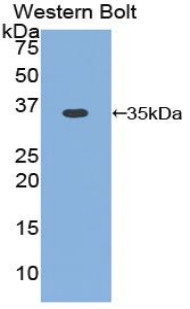Polyclonal Antibody to Cyclin D1 (CCND1) 

CCN-D1; BCL1; PRAD1; U21B31; G1/S-Specific Cyclin-D1; Parathyroid Adenomatosis 1; B-Cell CLL/Lymphoma 1; G1/S-Specific Cyclin D1; PRAD1 oncogene
Overview
Properties
- Product No.PAA585Ga01
- Organism SpeciesChicken (Gallus) Same name, Different species.
- ApplicationsWB
If the antibody is used in flow cytometry, please check FCM antibodies.
Research use only - DownloadInstruction Manual
- CategoryTumor immunityDevelopmental science
- SourcePolyclonal antibody preparation, Host Rabbit
- Ig Type IgG, Potency n/a
- PurificationAntigen-specific affinity chromatography followed by Protein A affinity chromatography
- LabelNone
- Immunogen RPA585Ga01-Recombinant Cyclin D1 (CCND1)
- Buffer FormulationPBS, pH7.4, containing 0.02% NaN3, 50% glycerol.
- TraitsLiquid, Concentration 0.24mg/mL
Sign into your account
Share a new citation as an author
Upload your experimental result
Review

Contact us
Please fill in the blank.
Specifity
The antibody is a rabbit polyclonal antibody raised against CCND1. It has been selected for its ability to recognize CCND1 in immunohistochemical staining and western blotting.
Usage
Western blotting: 0.01-2µg/mL;
Optimal working dilutions must be determined by end user.
Storage
Store at 4°C for frequent use. Stored at -20°C in a manual defrost freezer for two year without detectable loss of activity. Avoid repeated freeze-thaw cycles.
Stability
The thermal stability is described by the loss rate. The loss rate was determined by accelerated thermal degradation test, that is, incubate the protein at 37°C for 48h, and no obvious degradation and precipitation were observed. The loss rate is less than 5% within the expiration date under appropriate storage condition.
Organism Species More: Homo sapiens (Human), Mus musculus (Mouse), Rattus norvegicus (Rat)Giveaways
Increment services
-
 Antibody Labeling Customized Service
Antibody Labeling Customized Service
-
 Protein A/G Purification Column
Protein A/G Purification Column
-
 Staining Solution for Cells and Tissue
Staining Solution for Cells and Tissue
-
 Positive Control for Antibody
Positive Control for Antibody
-
 Tissue/Sections Customized Service
Tissue/Sections Customized Service
-
 Phosphorylated Antibody Customized Service
Phosphorylated Antibody Customized Service
-
 Western Blot (WB) Experiment Service
Western Blot (WB) Experiment Service
-
 Immunohistochemistry (IHC) Experiment Service
Immunohistochemistry (IHC) Experiment Service
-
 Immunocytochemistry (ICC) Experiment Service
Immunocytochemistry (ICC) Experiment Service
-
 Flow Cytometry (FCM) Experiment Service
Flow Cytometry (FCM) Experiment Service
-
 Immunoprecipitation (IP) Experiment Service
Immunoprecipitation (IP) Experiment Service
-
 Immunofluorescence (IF) Experiment Service
Immunofluorescence (IF) Experiment Service
-
 Buffer
Buffer
-
 DAB Chromogen Kit
DAB Chromogen Kit
-
 SABC Kit
SABC Kit
-
 Long-arm Biotin Labeling Kit
Long-arm Biotin Labeling Kit
-
 Real Time PCR Experimental Service
Real Time PCR Experimental Service
Citations
- Antiproliferative and proapoptotic activity of CLM3, a novel multiple tyrosine kinase inhibitor, alone and in combination with SN-38 on endothelial and cancer cellsScienceDirect: S0006295211002097
- The nanoparticulate Quillaja saponin KGI exerts anti-proliferative effects by down-regulation of cell cycle molecules in U937 and HL-62 human leukemia cellsPubmed: 24138332
- Antiproliferative and proapoptotic activity of sunitinib on endothelial and anaplastic thyroid cancer cells via inhibition of Akt and ERK1/2 phosphorylation and by down-regulation of cyclin-D1.Pubmed: 23969186
- Common Food Additive Carrageenan Stimulates Wnt/ β-Catenin Signaling in Colonic Epithelium by Inhibition of Nucleoredoxin ReductionPubmed:24328990
- MicroRNA-149 is epigenetically silenced tumor-suppressive microRNA, involved in cell proliferation and downregulation of AKT1 and cyclin D1 in human …pubmed:27783537
- Is there an association between enhanced choline and β-catenin pathway in breast cancer? A pilot study by MR Spectroscopy and ELISA.pubmed:28533512
- Development of a dietary formulation of the SHetA2 chemoprevention drug for mice.pubmed:29273857
- Metronomic vinorelbine is directly active on Non Small Cell Lung Cancer cells and sensitizes the EGFRL858R/T790M cells to reversible EGFR tyrosine kinase …Pubmed:29660315
- Licarin A induces cell death by activation of autophagy and apoptosis in non-small cell lung cancer cellsPubmed:29468481
- Vandetanib has antineoplastic activity in anaplastic thyroid cancer, in vitro and in vivoPubmed:29517106
- Lenvatinib exhibits antineoplastic activity in anaplastic thyroid cancer in vitro and in vivoPubmed:29517103
- Is there an association between enhanced choline and β-catenin pathway in breast cancer? A pilot study by MR Spectroscopy and ELISAPubmed: 28533512
- Antiapoptotic Effects of Continuous Training and Selenium Consumption on the Liver Tissue of Cadmium-Exposed RatsPubmed: 10.5812/mejrh.91278
- Synthesis of novel S-linked dihydroartemisinin derivatives and evaluation of their anticancer activityPubmed: 31216504






